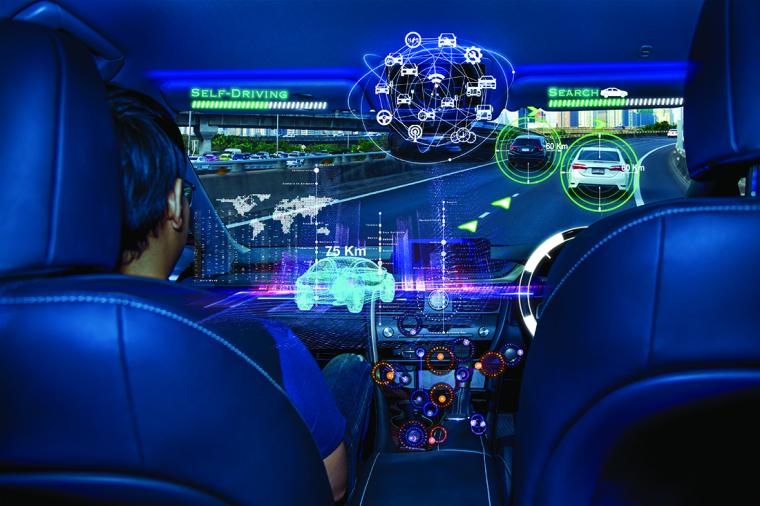
Artificial intelligence’s effects continue to expand rapidly across all major industries, with industries around the globe investing heavily in AI technologies to advance their competitive edge, and the automotive industry is no exception. Organizations that fail to adopt an AI strategy now risk falling far behind their competitors. When implemented correctly, AI and machine learning (ML) can deliver broad value to businesses across the auto industry. In fact, companies that have already adopted AI have reported that the technology has boosted customer satisfaction as well as bottom-line results. Research for this article found one of the easiest ways to move AI pilots to scaled deployments with tangible profits is to focus on one key objective: the consumer experience.
For automotive industry players racing to build the most efficient and safe self-driving car, it’s important to adopt a consumer-first mindset in order to succeed. The winners of this race will be those who invested considerable effort in enhancing consumer experience, both inside the cabin for drivers and passengers and outside the vehicle to improve safety and autonomy.
The Common Denominator is High-Quality Data
Automakers today are engaged in using AI to varying degrees. All companies are building driver assistance and connected car features into their vehicles, and most are simultaneously developing self-driving technology to develop fully autonomous vehicles. Achieving this objective means working with multiple vendors and applications to collect, label, prepare and converge the necessary data to train their AI models effectively.
But building the future of transportation is complicated enough without having to connect dozens of different data pipeline components, integrate and maintain a growing list of application programming interfaces, or APIs.
For a car to be able to “see,” “hear,” “understand,” “talk” and “think,” it needs video, images, audio, text, communications, LiDAR and sensor data to be properly collected, structured and interpreted by machine learning models. In the case of autonomous vehicles – similar to healthcare or other use cases that involve critical risk management -- training data must be annotated and verified by human workers at scale. This way, developers of the technology can be certain the machines are delivering the best accuracy every time and ensure that AI works for everyone.
Areas of Data Applications

Predictive maintenance. Artificial intelligence will prove to be a useful tool for predictive auto maintenance. Thanks to data provided by sensors and data analysis algorithms, AI is able to predict when a vehicle is likely to require maintenance, allowing owners and operators to plan and schedule repairs in advance. This reduces the chances of breakdowns and the cost of complicated repairs by catching minor issues early.
AI can be used to monitor factors such as engine performance, oil levels, tire pressure and more. The AI platform can then use this information to identify patterns and predict when maintenance will be required. For example, if the AI determines that a particular part is showing signs of wear and tear, it can message the driver or maintenance staff to replace the part before it fails. These systems are well placed to optimize maintenance schedules based on usage patterns, driving conditions and many other factors, ensuring vehicles are undergoing the right maintenance at the right time, reducing downtime and extending the lifespan of the vehicle.
Supply chain optimization. The use of AI for automotive supply chain optimization is another compelling application for the technology. AI improves the efficiency of the supply chain by analyzing data and making predictions about future demand, which can help optimize inventory, eliminate waste and streamline logistics operations.
This can lead to optimization of vehicle production schedules: AI algorithms can analyze production data and make more accurate predictions about demand, which allows automakers to adjust their production schedules in real-time to address changing market conditions. This, in turn, can reduce inventory levels and minimize production delays. One study conducted by Accenture found that using predictive analytics to analyze data from industrial equipment can predict when maintenance would be required.
Another area in which AI can improve the auto industry is in logistics optimization. AI-driven algorithms can analyze shipping data to identify the most efficient routes and transportation modes, which will reduce transportation costs and minimize delivery times.
Overall, the use of AI for supply chain optimization has the potential to improve efficiency, reduce costs and increase customer satisfaction. However, regardless of the progress being made, challenges remain in the standardization of data and potential bias in AI algorithms.
Human-robot collaboration (HRC). Of particular interest to the auto industry is the relationship between AI and human-robot collaboration. Research has found that the use of AI in HRC can lead to significant improvements in productivity, quality and safety. AI-powered robots are better able to work alongside human workers to perform routine, repetitive or physically demanding tasks such as lifting heavy objects or performing intricate assembly operations. When it’s driven by AI, HRC reduces the risk of injury and fatigue for human workers, while also improving efficiency and consistency in the manufacturing process.
AI can also be useful in HRC by improving the communication and coordination between human workers and robotic ones. By employing natural language processing (NLP) and computer vision technologies, AI systems can enable robots to better understand human instructions and gestures and provide feedback and guidance to human workers.
Moreover, AI is being used to optimize the performance of robotic systems in real time by analyzing sensor data and adjusting robot movements and actions based on changing environmental conditions and task requirements.
Several automotive companies such as BMW, Audi and Volkswagen have already begun to incorporate HRC into their manufacturing processes, and they have experienced promising results. However, further research is needed to fully explore the potential of AI in HRC and address the challenges and limitations of implementing such systems in real-world production environments.
Vehicle performance. The automotive industry has been at the forefront of adopting and integrating AI technologies to enhance vehicle performance, safety and reliability. Examples of these applications include:
• Autonomous driving. This involves using sensors and camera to detect the vehicle’s surroundings and make real-time decisions to optimize performance, fuel efficiency and safety. Autonomous driving is currently undergoing rigorous testing by many automakers.
• Fuel efficiency. AI is used to optimize fuel consumption by analyzing data from a vehicle’s sensors, GPS and other sources to adjust and improve acceleration, handling and other performance metrics.
• Driver assistance. AI-powered driver assistance systems are becoming increasingly common in modern vehicles. These systems use cameras and sensors to detect obstacles, warn drivers of potential hazards and even take control of the vehicle in emergency situations.

Personalized marketing. Customers increasingly expect marketing efforts to be tailored for them, and this becomes easier with the use of AI. Companies are better able to leverage the power of data and technology to deliver more targeted and effective marketing communications at the right time via the right channel. Following are some examples of elements of AI-driven personalized marketing campaigns.
• Consumer predictive analytics. By analyzing customer data such as search history, purchase behavior and social media activity, companies can use AI algorithms to identify patterns and predict future behavior. This data can then be used to tailor marketing messages and offers to individual customers based on their predicted preferences.
• Chatbots and virtual assistants. Another application of AI for personalized marketing in the industry is through the use of chatbots and virtual assistants. These tools can provide customers with personalized recommendations via a friendly AI interface based on their needs and preferences, as well as answer questions and provide support. For example, a customer might ask a chatbot for advice on which car to buy based on their budget, driving habits and other preferences.
• Targeted advertising. AI can also be used to deliver targeted advertising messages to customers based on their demographics, interests and behaviors. For example, a company might use AI algorithms to identify customers who are most likely to be interested in a particular car model or feature and deliver marketing materials and messages to them through social media, search engines or other digital channels.
• Personalized content. AI is also being used successfully for personalized marketing by creating customized content for consumers. This might include tailored videos, blog posts or other content that has been designed to appeal to a customer’s specific interests and preferences.
Overall, the use of AI for personalized marketing in the automotive industry is a rapidly growing segment with significant potential. By leveraging the power of data and technology, companies can deliver more targeted and increasingly effective marketing campaigns that are tailored to individual customers’ needs and preferences.
Relevant Research
Throughout virtually all industry groups, AI is playing an increasingly important role. In the automotive industry, some of the major players include:
Tesla. Tesla is one of the leading companies in the development of AI for self-driving vehicles. The electric vehicle company’s research teams are actively working on AI algorithms for autonomous driving, and the company’s self-driving cars are using advanced sensors and machine learning algorithms to navigate roads safely.
Waymo. Waymo, a subsidiary of Alphabet Inc. (Google’s parent company), is a self-driving technology company that is developing a fully autonomous driving system using AI. The company is developing an AI-powered platform that can handle a variety of driving scenarios and can make real-time decisions to ensure passenger safety.
BMW. This European based manufacturer has been investing in AI for several years and has a team of researchers working on developing AI algorithms for self-driving cars. The company is focused on developing AI-powered systems that can help drivers stay safe and avoid accidents.
General Motors. GM’s, research teams are also focused on the development of AI algorithms for their vehicles. Their use of sensors and machine learning algorithms to navigate roads safely are the main thrust of their multi-year research and development efforts.
Ford. Ford has also been making significant research and development investments in AI for autonomous driving. The Michigan-based automaker has teams of researchers working to develop AI algorithms for their vehicles. Like other major manufacturers, Ford is developing a platform that can handle a variety of driving scenarios and make real-time decisions to ensure passenger safety.
Statistical Impact
The impact of AI on the automotive industry can be measured through various statistical data points, such as:
Market size. The size of the AI market in the auto industry is a key indicator of its influence. According to a report by MarketsandMarkets, the AI market in the auto industry segment is expected to reach $10.73 billion by 2025 and grow at a compound annual growth rate (CAGR) of 37.4 percent from 2020 to 2025.
Adoption rate. According to Accenture, 77 percent of automotive executives believe that AI will have a significant impact on their industry between now and 2025.
Job creation. AI is expected to create 2.3 million jobs by 2030, primarily in the fields of data scientists, machine learning engineers and AI system integrators.
Final Takeaways
The future of AI applications in manufacturing, in general, is yet to be fully understood or realized. The technology’s impact on auto manufacturing, production efficiencies and the customer experience are still works in progress. As AI continues to evolve and improve, we can expect to see even more advanced and innovative applications in future generations of vehicles. T&ID

